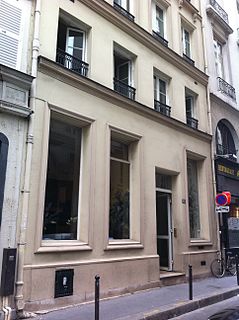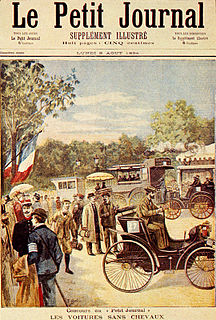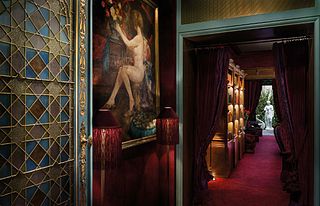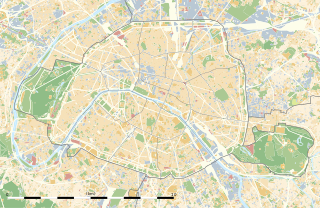
A brothel, bordello, or whorehouse is a place where people engage in sexual activity with prostitutes. Technically, any premises where prostitution commonly takes place qualifies as a brothel. However, for legal or cultural reasons, establishments often describe themselves as massage parlors, bars, strip clubs, body rub parlours, studios, or by some other description. Sex work in a brothel is considered safer than street prostitution.

Le Sphinx was a maison close (brothel) in Paris in the 1930s and 1940s. Along with the "Le Chabanais" and "One-Two-Two" it was considered one of the most luxurious and famous Parisian brothels.

Aristide Boucicaut was a French entrepreneur who created Le Bon Marché, the first modern department store.

Le Chabanais was one of the best known and most luxurious brothels in Paris, operating near the Louvre at 12 rue Chabanais from 1878 until 1946, when brothels were outlawed in France. It was founded by the Irish-born Madame Kelly, who was closely acquainted with several members at the Jockey-Club de Paris. Among the habituées were Albert, Prince of Wales ; Toulouse-Lautrec; Cary Grant; Humphrey Bogart, Mae West and diplomatic guests of the French government.

The sol, later called a sou, is the name of a number of different coins, for accounting or payment, dating from Antiquity to today. The name is derived from the solidus. Its longevity of use anchored it in many expressions of the French language.

Paris–Rouen, Le Petit Journal Horseless Carriages Contest, was a pioneering city-to-city motoring competition in 1894 which is sometimes described as the world's first competitive motor race.

Marguerite Gourdan, née Marguerite Alexandrine Ernestine Stock was a French brothel owner and procurer in 18th-century Paris. Her brothel was the most exclusive in Paris during that age, and Gourdan was arguably the most famous of her profession.

During the Second French Empire, the reign of Emperor Napoleon III (1852–1870), Paris was the largest city in continental Europe and a leading center for finance, commerce, fashion, and the arts. The population of the city grew dramatically, from about one million persons to two million, partially because the city was greatly enlarged through the annexation of eleven surrounding communes. These additions, which led to the creation of eight new arrondissements, brought the city to its present boundaries. In 1853, Napoleon III and his prefect of the Seine, Georges-Eugene Haussmann, began a massive public works project, constructing new boulevards and parks, theaters, markets and monuments, a project he continued seventeen years until his downfall.
Loi Marthe Richard of April 13, 1946 abolished the regime of regulated prostitution in France that had been in force since 1804. It required the closure of brothels. The law bears the name of Marthe Richard, who was a municipal councillor of Paris but not a parliamentary representative.

La Fleur blanche was a famous maison close (brothel) in the city of Paris, located at 6 rue des Moulins in the 1st Arrondissement. The property was also known as rue des Moulins and was famous for its torture room.

Maison Souquet is a 5-star hotel, part of Maisons Particulieres Collection, located at 10, rue de Bruxelles in Paris, on the outskirts of Montmartre. The hotel is inspired by the Parisian brothels from the Belle Époque period. Maison Souquet is decorated by the French designer Jacques Garcia.

The One-Two-Two was one of the most luxurious and illustrious brothels of Paris in the 1930s and 1940s. The name was taken from the address, 122 Rue de Provence, 8th arrondissement of Paris. The numbers were translated into English to ensure that foreign tourists would be able to find the brothel and as a password for French people.

The Aux Belles Poules was a well-known Parisian maison close (brothel), established at 32-34 Rue Blondel in the 2nd Arrondissement.

L'Étoile de Kléber was a maison close (brothel) in Paris. It obtained notoriety for continuing to run after the 1946 Loi Marthe Richard ban on brothels. It continued its operations for a while in secret.

The Lanterne Verte(Fr. Green Lantern) was a brothel in Paris. It was located on the corner of Rue de Chartres and Rue de la Goutte d'Or in the Goutte d'Or district in the 18th arrondissement, and was one of the more moderate brothels of Paris. The unusual thing about this brothel was that it had no rooms. The writer and poet Sylvain Bonmariage describes it in his book Gagneuses as follows:
"The Lanterne Verte was a brothel; it was declared as such, and in its large hall, furnished as a cafe, naked girls served the offer of the house. A schoppen white wine cost a franc and who wanted to fuck with the girls or wank one, the waitress was paid forty sous. Everything happened on a bench or chair of the establishment: there were no rooms. Customers entering were usually surprised at two or three pairs who were just in full swing. This Lanterne Verte was a prosperous business; each waitress served thirty customers on average between twelve o'clock and five o'clock in the morning, which brought her sixty francs".
The authorities of medieval Paris attempted to confine prostitution to a particular district. Louis IX (1226–1270) designated nine streets in the Beaubourg Quartier where it would be permitted. In the early part of the 19th century, state-controlled legal brothels started to appear in several French cities. By law, they had to be run by a woman and their external appearance had to be discreet. The maisons were required to light a red lantern when they were open and the prostitutes were only permitted to leave the maisons on certain days and only if accompanied by its head. By 1810, Paris alone had 180 officially approved brothels.
Xdolls is a business housed in an apartment in Paris where customers rent time with lifelike silicone sex dolls. Registered as a gaming center, it opened in 2018 and that March survived a challenge brought by Communist members of the Council of Paris after police declared it does not violate the prohibition on brothels in France.
Prostitution in Paris, both street prostitution and prostitution from dedicated facilities has a long history but also its own modernity in the French capital. Prostitutes are mostly women but also include transgender people and men.

The Palais Oriental, known locally as the PO, was a luxury maison close (brothel) in Reims, France. It opened in 1926 and closed in 1946, following the introduction of the Loi Marthe Richard, which abolished brothels in France. It was located on the corner of the rue de la Magdeleine and rue Bacquenoi. The prestige of the Palais Oriental rivalled that of Paris's most luxurious maison closes, the One-Two-Two and Le Chabanais.

The history of prostitution in France has similarities with the history of prostitution in other countries in Europe, namely a succession of periods of tolerance and repression, but with certain distinct features such as a relatively long period of tolerance of brothels.















